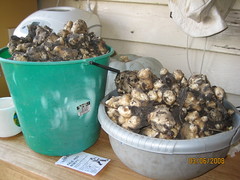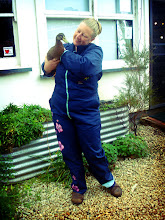Essene Bread

There is a recipe in this year's Permculture Diary for Essene Bread by Carey 'Eco' Priest. I've been getting back into cooking recently, mainly due to hanging out with Lisa, who is a spectacular cook! Life in the Tagari office is punctuated with apple pies with home made pastry and homegrown apples, cinnamon scrolls, chestnut cake... mmm chestnut cake...

Where was I? oh yes, Essene bread. Its a bread made from sprouted grain. I did a small one to start off with, about 2 cups of whole organic oats (I love oats and they grow them locally) just sprouted with a short tail. They took about 4 days to get to this stage.

Grind up the sprouts. I used a mortar and pestle and got into it so much I had to take my jumpers off on an icy night in Tassie. You can use a food processor, which I might do next time, being careful not to burn it out, or an old fashioned mincer.

I probably needed to mince a bit further from the stage below but it worked anyway

Then I kneaded and shape the sticky dough, wetting the hands regularly. The oats didn't take too much kneading but apparently wheat likes lots and rye none at all!
Once shaped I created a non stick surface using my breakfast cereal, rolled oats and rolled quinoa and placed the dough on top.

Ducky likes to inspect the work

Then its into a very low oven or solar cooker if you have one (they rock). I used the wood stove here on low and roasted chestnuts on the top while I was waiting.

I didn't think to photograph the finished product in the morning so you'll have to take my word for it that it turned a lovely caramel colour and everyone at work enjoyed their small pieces. I finished off the overly crunchy bits (meant to cook for 2 hours or so but I had left it in overnight) as snacks all afternood and was extremely happy to know I was nibbling away on tasty baked goods that were not bad for me! Awesome. Next time I'm going to make a loaf and some biscuits. Fabulous!
Essene Biscuits made with sprouted wheat and honey, minced in a food processor with some difficulty - I had to add some oat milk - I can see why people use old fashioned mincers.
I added honey for extra sweetness and I forgot to knead it (possibly because it was a bit sloppy from the machine).
They were cooked on baking paper spread with oats to make an awesome non stick but natural surface.

Goey on the inside, needed more drying time but yummy
Try a recipe from
http://www.growyouthful.com/recipes/sourdough-essene.php










